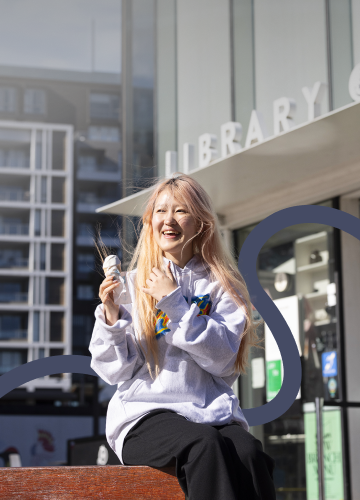Overview
This leadership goal was developed to reflect our commitment to meaningfully contribute to the United Nations Sustainable Development Goals1, and reduce the impact of shocks and stresses to communities and infrastructure, as identified by Resilient Sydney2 (part of the Rockefeller Foundation 100 Resilient Cities Program).
Within this pillar, Landcom focuses on how well a place delivers quality of life to its communities and the resilience of those communities. It encompasses economic prosperity and affordability, social stability and equity, accessibility, education, health and wellbeing, and integration of culture and heritage.
Liveable communities are healthy and inclusive. A well‑designed community takes into account the needs of people today, and the needs of our future generations. We consider where people will work, learn, spend their leisure time and how they move from place to place.
Landcom also believes that the built environment should incorporate green spaces and retain a connection to our natural habitats for the benefit of the environment and our communities.
Landcom addresses liveability through the following focus areas:
- Health, Equity & Inclusion, Community Connection and Safety
- Affordability and Diversity
- Design through Engagement.
Each of these focus areas includes a suite of targets to measure our success.
_________________________
Case Studies
Management Approach
Landcom adopts a holistic approach to the delivery of healthy and inclusive places founded on equity for people of all ages and abilities.
For new projects we undertake social needs assessments to understand what amenities, services or programs are currently available to the immediate and surrounding community, and what gaps may need to be filled. We use this information to inform our future planning for infrastructure and community development programming.
As residents begin to live onsite, we commence a continuous feedback loop by gathering data from residents of Landcom communities to measure satisfaction with quality of life. We have adopted performance targets for this, and strive for continuous improvement to meet the quality of life expectations of current and future residents. We have updated our Healthy & Inclusive Places targets as part of our ongoing commitment to continuous improvement. From FY24 our projects will report against these updates. You will see them embedded within our performance disclosures. Please note our FY23 to FY24 may not be directly comparable in all circumstances. Footnotes are included as a reminder where this is relevant.
Since 2018, Landcom has utilised our Healthy and Inclusive Places Survey (HIPS) as the primary measure to determine the drivers of satisfaction across communities, and track performance. From FY23 onwards we have replaced the use of HIPS with Place Score. This is an independently managed liveability census. Read more about Place Score here. Landcom has chosen to align with Place Score to benefit from their nation wide data and analytics.
Our FY24 performance results are repeated from the previous year as Place Score’s survey is bi-annual. See Health, Equity & Inclusion, Community Connection, and Safety.
Landcom’s Housing Policy sets targets to drive the delivery of Affordable, Diverse and Universal Housing. Affordable Housing includes housing that is managed by a Community Housing Provider (CHP)1 as well as private market housing which is affordable2 for purchase by moderate or below moderate-income households.
Diverse Housing is housing that increases the mix of housing stock in the area in which it is being delivered. For example, housing that offers an alternative to the predominant type in the area; caters for specific resident needs; or offers alternative to traditional ownership and rental tenures.
Universal Housing is housing that is certified as meeting or exceeding Livable Housing Australia’s Silver Level Certification requirements. This helps to ensure that any person can use a dwelling, irrespective of age, level of mobility, or condition of health. It also means homes can be adapted to accommodate changing needs, such as ageing in place, or supporting those with disability.
When we adopted the Sustainable Places Strategy, Landcom did not have a Housing Policy and housing affordability and diversity was a lower priority issue for the NSW government. This has now become a significant focus and our maturity in addressing the matter has also refined. Landcom now has a comprehensive Housing Policy with clear targets.
As these are subject to change on a regular basis we have made the decision to move our reporting on housing affordability and diversity to our Annual Report.
We will still address resident perceptions of affordability and diversity in our Sustainability Report, and share our efforts and achievements in reducing the cost of living for new residents.
_________________________
1 Not-for-profit organisations that build and/or manage housing for eligible people on very low, low and moderate incomes or who are unable to access appropriate housing in the private market.
2 The maximum threshold for affordable ownership is the purchase price at which a household earning 120% of the median income spends no more than 30% of their gross annual income on mortgage repayments.
We maintain a commitment to excellence in design and meaningful stakeholder participation from all those who have a stake in the evolution of our cities, including the communities which know them best.
Landcom has an established Design Review Panel (DRP) who provide expert review of projects in concept or masterplan design, with the aim of achieving design excellence.
The DRP provides advice to Landcom on strategies to achieve design excellence and quality of urban design as well as built form outcomes across our project portfolio.
In FY24 the membership of the Landcom Design Review Panel was updated as part of a regular review. The updated panel consists of five expert members, with key skills in urban design, architecture, landscape architecture and sustainable and resilient design.
Landcom also updated the Design Review Panel Charter in FY24. The Charter has been endorsed by Government Architect NSW.
As part of our management approach all projects are required to present to the DRP as they progress through the masterplan and design stages.
For our FY24 performance against our Design through Engagement targets, see Design through Engagement Performance Results.
We aim to be:
|
Collaborative Working with stakeholders with an interest in delivering positive project outcomes |
Purposeful Planning and resourcing engagement to support project delivery |
|
Proactive Engaging stakeholders early and throughout project planning and delivery and making it easy for them to participate |
Accountable Being clear about the purpose of engagement, level of influence and how the influence has shaped recommendations and decisions |
|
Inclusive Engaging stakeholders with different needs and interests |
For our FY24 performance against our Design through Engagement targets, see Design through Engagement Performance Results.
Performance Results
See below our performance results for each of the reporting areas within our Healthy & Inclusive Places Pillar.
Health, Equity & Inclusion, Community Connection & Safety
Targets
Performance
2036 Goal: 90% of residents satisfaction with quality of life
FY23 Performance
82%
FY241 Performance
82%
Targets
Residents report their community has access to high quality amenities, services or employment
FY23 Performance
75%
FY241 Performance
75%
Targets
Residents report high physical and mental health
FY23 Performance
87%
FY241 Performance
87%
Targets
New from FY241: Residents report the design of their community is resilient and best practice
FY23 Performance
n/a
FY241 Performance
85%
Targets
Residents report their community has a sense of character or identity unique from other neighbourhoods
FY23 Performance
74%
FY241 Performance
74%
Targets
Residents report a sense of belonging and support from their community
FY23 Performance
84%
FY241 Performance
84%
Targets
New from FY241: Residents report their community is a 20-minute neighbourhood
FY23 Performance
n/a
FY241 Performance
77%
Targets
Resident satisfaction with personally feeling safe
FY23 Performance
91%
FY241 Performance
91%
1 FY23 results carried forward due to Place Score’s National Liveability Census being bi-annual.
During the reporting year we continued to implement our community development approach by leveraging strategic partnerships to deliver initiatives that foster community connection and focus on health and wellbeing.
As in previous years, a strong emphasis was placed on projects where Landcom partners with Homes NSW (formerly Land & Housing Corporation) to deliver social and market housing, in order to drive greater equity and access to programs and services. We also maintained a strong place making program at Sydney Metro Northwest Places.
Activities undertaken in FY24 that supported community health, equity and inclusion included:
- Live Life Get Active free fitness classes at Hillcroft in Claymore, Newbrook in Airds, Macarthur Heights and Bella Vista
- National Theatre for Children – mental health programs at Hillcroft and Newbrook
- Learn to skate workshops at Bella Vista
- Dance classes at Bella Vista
Impact reports for Live Life Get Active fitness class members show health improvements across all four Landcom supported camps. Key indicators include reduced risk of health issues like pre-diabetic risk and obesity.
We also continued our focus on mental health awareness with the National Theatre for Children’s live theatre performance ‘Mind Masters’. This is a mental resilience education program. (For further detail and results from Mind Masters education program see here).
Activities undertaken in FY24 that supported community connection and the integration of culture and heritage include:
- Movie night at Hillcroft and Newbrook
- A Patch from Scratch gardening event at Bella Vista
- Public artwork installation at Bella Vista
- Muralisto community day at Bella Vista
- Coffee catch ups with kids entertainment
- Seasonal community events including a Harmony Day celebration at Bella Vista, Christmas, Easter, Spring Fair, and NAIDOC at Hillcroft.
The FY23 results for satisfaction with Community Connection were carried forward for FY241. The results represent a significant uplift from previous years at 84% resident satisfaction. Respondents were asked to rate their satisfaction against community connection factors such as; sense of belonging, mix of diversity of people, community activities, sense of connection and feeling support from neighbours or community.
We also saw a positive shift in result for the Integration of Culture and Heritage (74%1 satisfaction). Respondents rated their satisfaction against elements such as; sense of character or unique identity, cultural and/or artistic community, local history, historic features and unique public space design.
Residents report high levels of overall perceived safety (91%1) in their communities. Place Score respondents were asked to consider:
- Sense of personal safety (for all ages, genders, day or night)
- Sense of neighbourhood safety (from crime, traffic, pollution etc.)
Throughout the design process we continue to adopt best practice Crime Prevention through Environmental Design (CPTED) principles.
Affordability & Diversity
Landcom’s Sustainable Places Strategy addresses Affordability & Diversity. This focus area forms part of our Healthy & Inclusive Places pillar and is a representation of our commitment to delivering affordable and sustainable communities.
Increasing affordability challenges across NSW are inextricably linked to sustainable development and we are looking at innovative ways to increase the equity and inclusivity of our communities.
As Landcom’s housing targets are subject to frequent fluctuation under Ministerial guidance, reporting on progress has been moved to the Annual Report. You can see our latest results here.
While the supply and delivery of affordable and diverse housing is essential, the lived experience is also an important factor that Landcom seeks to measure. As part of the Place Score Census, in FY24 we collected resident feedback on the diversity and affordability of Landcom communities. Following are the results reported by residents1:
- Residents report a good range of housing types and sizes in their community scoring 7.6 out of 10
- Satisfaction with the range of housing prices and tenures in their community is slightly lower with a score of 6.5 out of 10.
In FY24 we also continued to fulfil our Sustainability Rebate at Macarthur Heights. The $15,000 sustainability rebate helps residents building new homes achieve BASIX 90 home energy ratings. The incentive aims to help make homes more resilient and lower the cost of living for new home builders in our communities.
Overall we estimate homes that opt into our rebate and achieve a BASIX 90 score will save money each year on the running costs of their homes. By also requiring that these dwellings are all electric they are set up for the decarbonising economy and are more resilient to the energy demands of the future and generally experience lower energy bills.
1 Results using Place Score data from the 2023 National Liveability Census.Design through Engagement
Targets
Performance
All new projects to undergo peer review through the Landcom Design Review Panel (or equivalent)
Performance
FY23 Performance
100%
FY24 Performance
100%
Targets
All projects have an engagement plan
Performance
FY23 Performance
100%
FY24 Performance
100%
Our approach to working with the people, groups and organisations that have an interest, that will be directly impacted, or have an ability to influence our projects is guided by our Join In stakeholder engagement framework. The framework outlines our commitment to stakeholder engagement and to continued learning and improvement in our engagement practice to help create more affordable and sustainable communities.
In FY24 there were 14 projects with up to date and fit-for-purpose communications and engagement strategies in place. This includes a plan for the Sydney Metro Northwest Places program, which will provide around 10,000 new homes once complete and includes the Cherrybrook, Hills Showground, Bella Vista and Kellyville station precincts.
We had plans in place for our North Wilton, Macarthur Gardens North, Queenscliff, Austral, Schofields, Wentworth Point, Guntawong Road, Bulli, Rooty Hill, Orange, Bomaderry built-to-rent and East Lismore built-to-rent projects. These plans outline how we will inform local communities and stakeholders about project planning and, where appropriate, invite community feedback to help shape these plans.
During FY24 we held proactive community engagement campaigns to support planning and decision-making at various stages in our development process. This year there was an emphasis on visioning consultation, to ensure we understand community values at the start of a project. We also prioritised progressing our Connecting With Country practice, by undertaking walks on Country on new projects and building relationships with First Nations stakeholders.(See our Case Study Connecting with Country and Visioning for new communities).
During FY24 all projects within our business development portfolio, or active projects undertaking masterplanning or reviewing design and delivery options, presented to the DRP.
In FY24 there were 13 separate design review sessions with the Panel including projects such as Glenfield, Rooty Hill, and the build-to-rent project at Bomaderry.
The DRP provides expert review of projects in concept or masterplanning design, with the aim of achieving design excellence.
Our Sustainable Places Strategy
Our Sustainable Places Strategy with four Leadership Goals guides the way we deliver new communities. Our FY24 performance for each part of our strategy is accessible below.




















